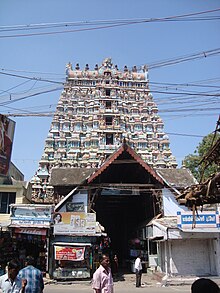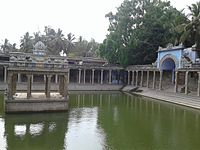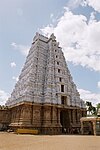Nellaiappar Temple
| Nellaiappar Temple | |
|---|---|
Tirunelveli | |
 | |
| Religion | |
| Affiliation | Hinduism |
| District | Tirunelveli |
| Deity | Nellaiappar (Shiva)
Kanthimathi Amman ( Medieval Cholas |
| Completed | 700 CE |
| Direction of façade | East |
| Website | |
| http://kanthimathinellaiappar.tnhrce.in/ | |
The Nellaiappar Temple is a
The temple complex covers an area of 5.9 hectares (14.5 acres) and all its shrines are enclosed with concentric rectangular walls. The temple has a number of shrines, with those of Swamy Nellaiappar and his consort Sri Kanthimathi Ambal being the most prominent.
The temple has three six rituals at various times from 6:00 a.m. to 9:00 p.m., and six yearly festivals on its calendar. Brahmotsavam festival during the Tamil month of Aani (June–July) is the most prominent festival celebrated in the temple.
The original complex is believed to have been built by
History


Tirunelveli is one of the many temple towns in the state which is named after the groves, clusters or forests dominated by a particular variety of a tree or shrub and the same variety of tree or shrub sheltering the presiding deity. The region is believed to have been covered with Venu forest and hence called Venuvanam.[1]
The original complex is believed to have been built by Pandyas, while the present masonry structure was added by Cholas, Pallavas, Cheras, and Madurai Nayaks. The sanctums of the temple and the gopurams were constructed by Nindraseer Nedumaran (Koon Pandian) who reigned in the 7th century AD. The mani mandapam with its famous musical pillar was also likely built by Nindraseer Nedumaran. The flag stand near the Nandi was set up in 1155.[2] Later Pandya, Kulasekara Pandyan I built the outer wall of the Thirunelveli Nellaiappar temple, in 13th century.
Originally, the Nellaiappar and Kanthimathi temples were two independent structures with spaces in between. It was in 1647 that Thiru Vadamalaiappa Pillaiyan, a great devotee of Siva linked the two temples by building the "Chain mandapam" (In Tamil Sangili Mandapam). In the centre of the Flower Garden is a square vasantha mandapam with 100 pillars. The Nandi mandapam is said to have been built by Sivanthiappa Nayakar in 1654. To the western portion of the chain mandapam is the flower garden that was set up in 1756 by Thiruvengadakrishna Mudaliar.[3]
There are a number of stone inscriptions in the temple. The most important of them are those Veerapandiyan who reigned around 950 AD and those of
Legend
Tirunelveli was originally called Tinnevelly during the British Era. During Puranic times, the place was called Venuvana, a forest of bamboos. The deity in the current temple was believed have appeared inside the bamboo forest.
Architecture


The temple complex covers an area of 5.9 hectares (14.5 acres), measuring 260 metres (850 ft) long and 230 metres (756 ft) wide, and all its shrines are enclosed with concentric rectangular walls, with a massive Rajagopuram.[6] Sangili Mandapam built on 1647 by vadamalaiyappa pillayan connects the Ganthimathi Amman and Nellaiyappar temples.[7] The temple has a number of shrines, with those of Swamy Nellaiappar and his consort Sri Kanthimathi Ambal being the most prominent.
The Nandi mandapam has a fairly big statue of Nandi (the bull God), similar to those at Tanjore and Rameswaram . The unique feature of the temple is the 'Mani manadapam' located near the nandi mandapam with two giant pillars carved out of a single stone and each one is having 48 sub pillars which produce musical notes when struck. Tamil poet says that the pillars here are a combination of the Shruti Gana Laya types.[8]
The composite columns of
Thaamira Ambalam
Pancha Sabhai Sthalangal

The temples where Shiva is believed to have performed the Cosmic Dance. This temple is called Tambra Sabha (copper hall) based on the dance pose of Nataraja. There are several architectural depictions in the temple detailing the legends.[5]
| Category | Temple | Location | Element |
| Rathina sabai | Sri Vadaranyeswarar Temple | Thiruvalangadu, Chennai | Ruby |
| Porchabai | Natarajar Temple
|
Chidambaram | Gold |
| Velli sabai | Meenakshi Amman Temple
|
Madurai | Silver |
| Thamira sabai | Nellaiappar Temple | Tirunelveli | Copper |
| Chithira sabai | Kutralanathar Temple | Thirukutralam | Art |
Religious importance and festivals


Navaratri, Tirukkalyanam in Aippasi, (15 October – 15 November) and Arudra Darisanam are some of the important festivals here. Arudra Darisanam attracts huge crowds here. The temple chariot is a massive one, second supposedly only to Tiruvarur. The Bhrammotsavam here lasts for an extended period of time during the Tamil month of Aani (15 June – 15 July). Also, a golden temple car (First Inaugural run of Nellaiappar Temple Golden Car is 2 November 2009) will run during important festivals like Thirukalyanam, Kaarthigai, Aaruthra Festival etc. During
The temple priests perform the
Literary mention
References
- ISBN 978-81-7823-542-4.
- ^ Sthala Varalaru book published in 2004 by temple administration
- ISBN 978-81-8094-432-1.
- ^ "Archived copy". Archived from the original on 19 December 2017. Retrieved 15 April 2020.
{{cite web}}: CS1 maint: archived copy as title (link) - ^ ISBN 81-206-0151-3.
- ^ a b "Muthuswami Dikshithar". Retrieved 28 April 2015.
- ^ Thirukkoilkal vazhikaatti, Tirunelveli District; tnhrce; August 2014;page 11
- ^ "Arulmigu Nellaiappar Temple,Tirunelveli". kanthimathinellaiappar.tnhrce.in. Retrieved 2 October 2020.
- S2CID 154135978.
- ^ T. G. S. Balaram Iyer, T. R. Rajagopalan (1987). History & description of Sri Meenakshi Temple. pp.39
- ^ Rajeshwari Ghose. The Tyāgarāja cult in Tamilnāḍu: A Study in Conflict and Accommodation . pp. 69
- ^ "Arulmigu Nellaiappar Temple,Tirunelveli". Archived from the original on 5 December 2018. Retrieved 13 December 2015.
- ^ "Sri Nelliapaar temple". Dinamalar. 2014. Retrieved 24 November 2015.
- ^ a b R., Dr. Vijayalakshmy (2001). An introduction to religion and Philosophy – Tévarám and Tivviyappirapantam (1st ed.). Chennai: International Institute of Tamil Studies. pp. 315–7.
External links
- Nellaiappar Temple official site
- Nellaiappar Temple at Tirunelveli
- Nellaiappar Temple, Tirunelveli
 Nellaiappar Temple travel guide from Wikivoyage
Nellaiappar Temple travel guide from Wikivoyage



